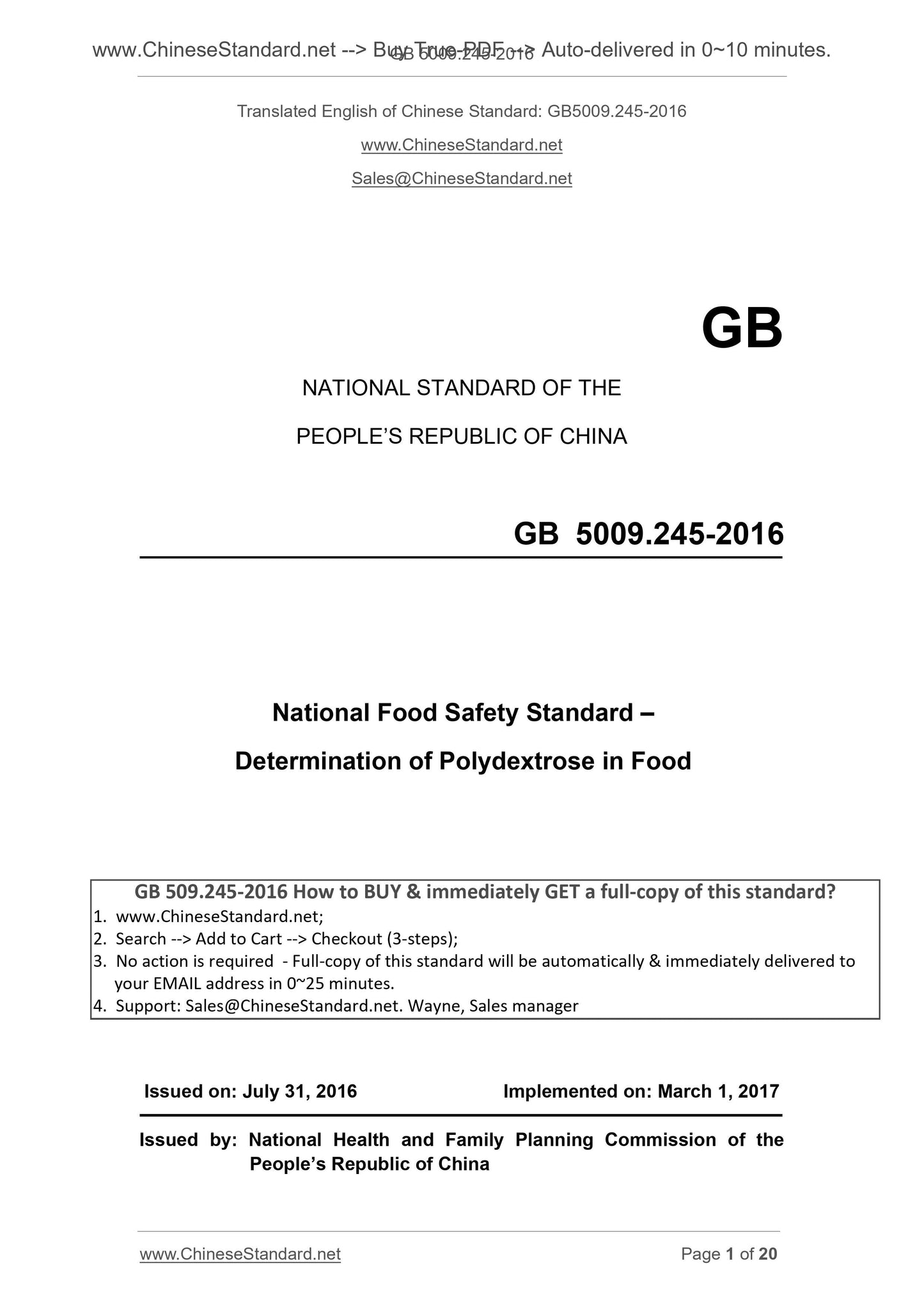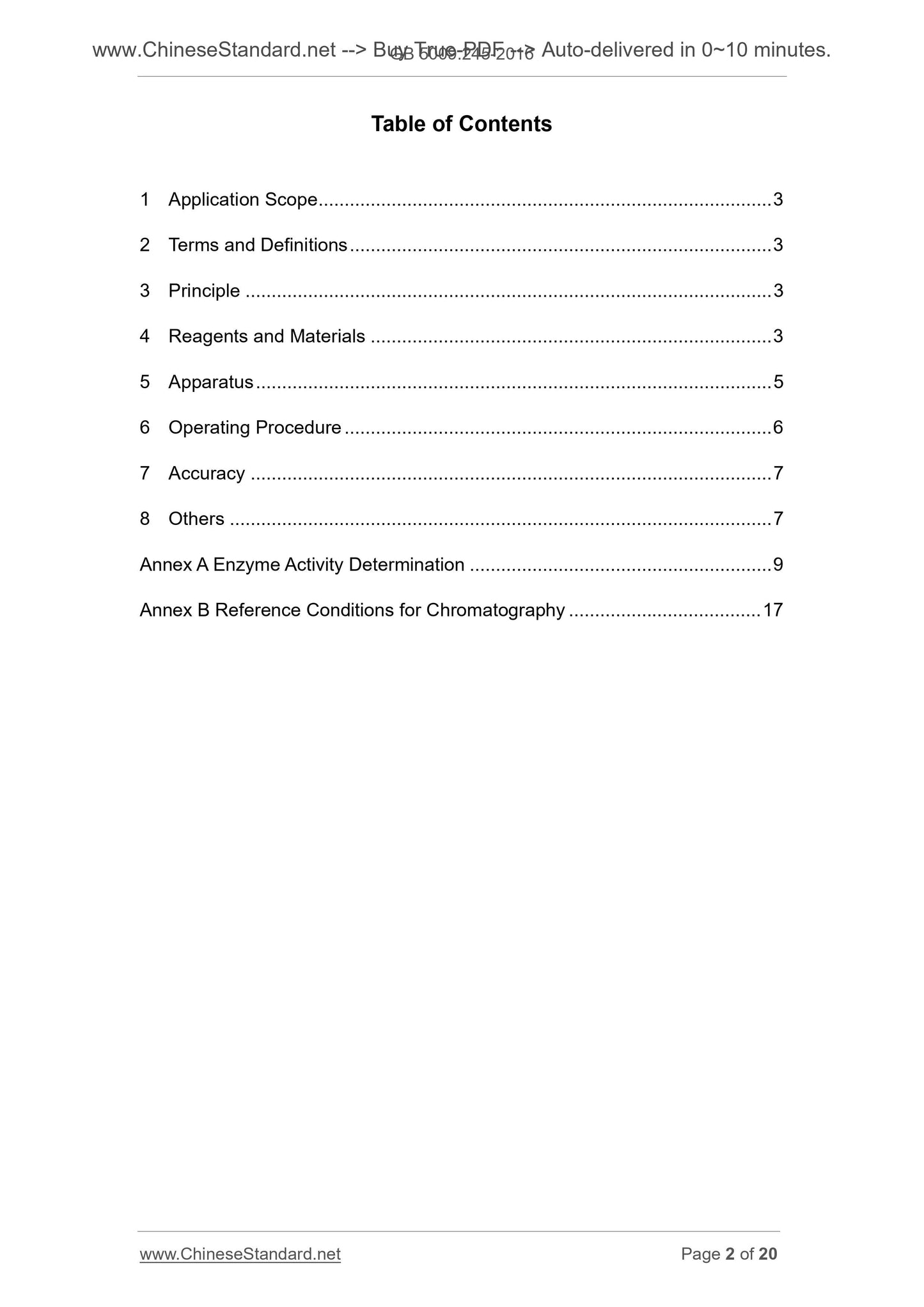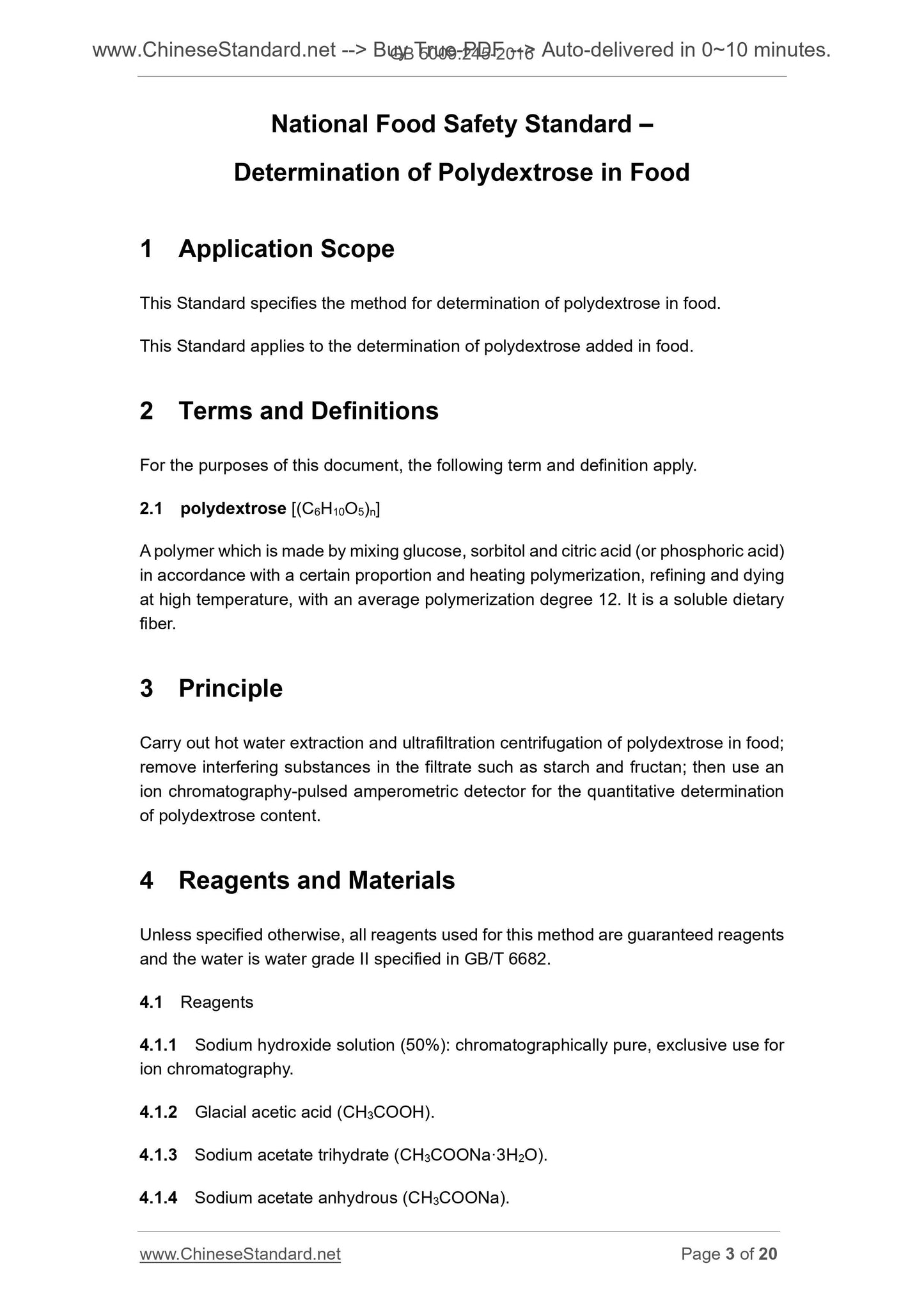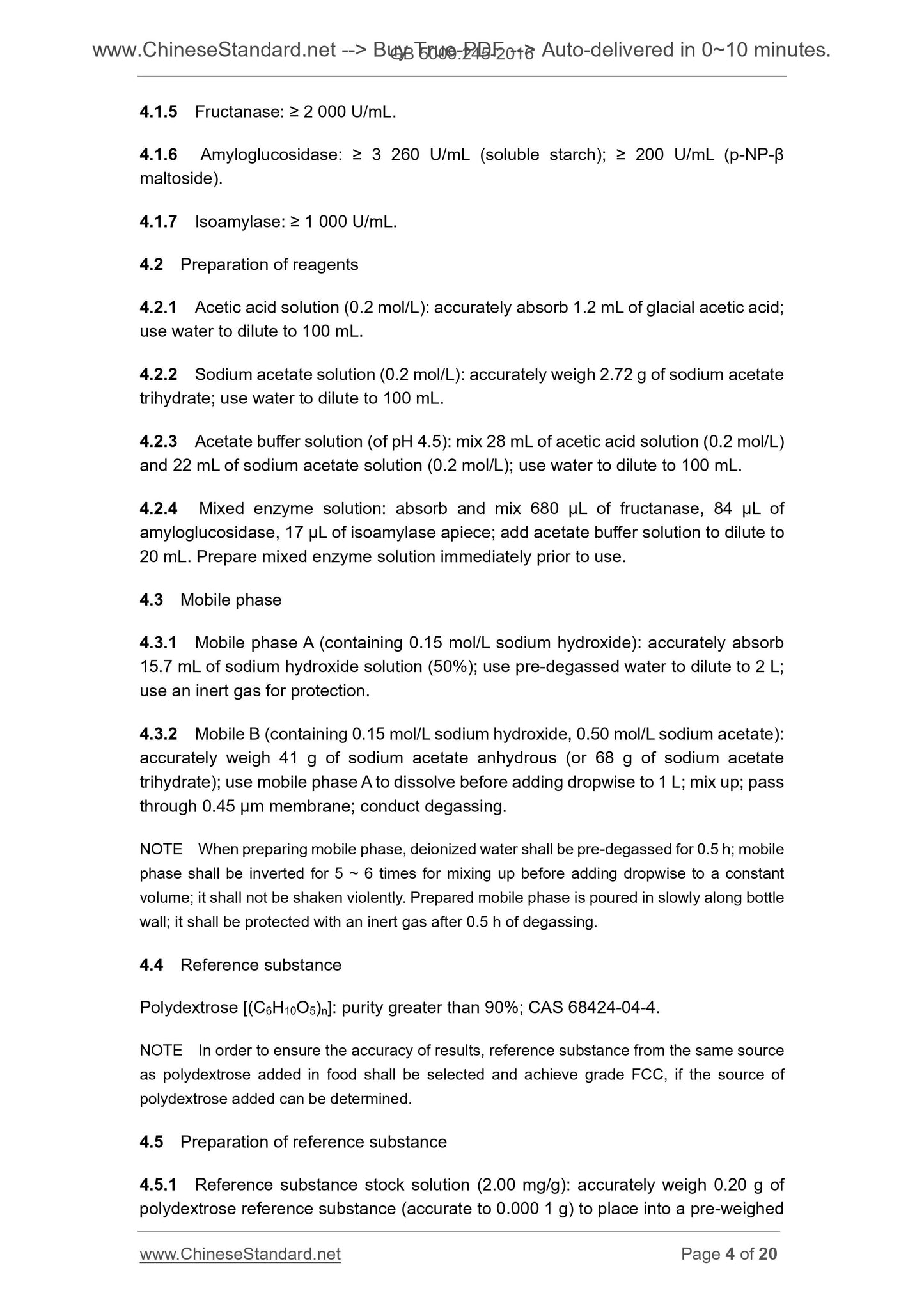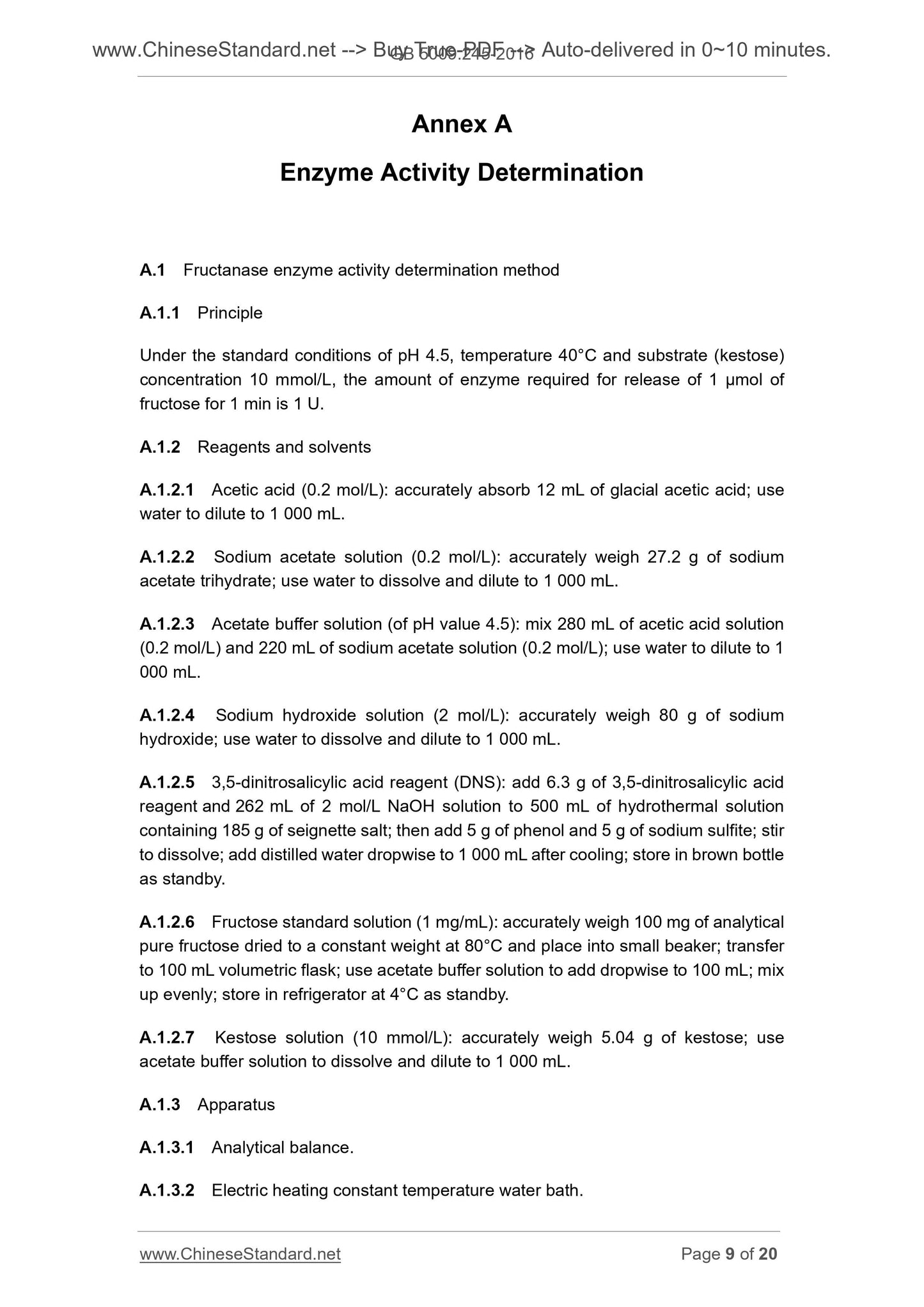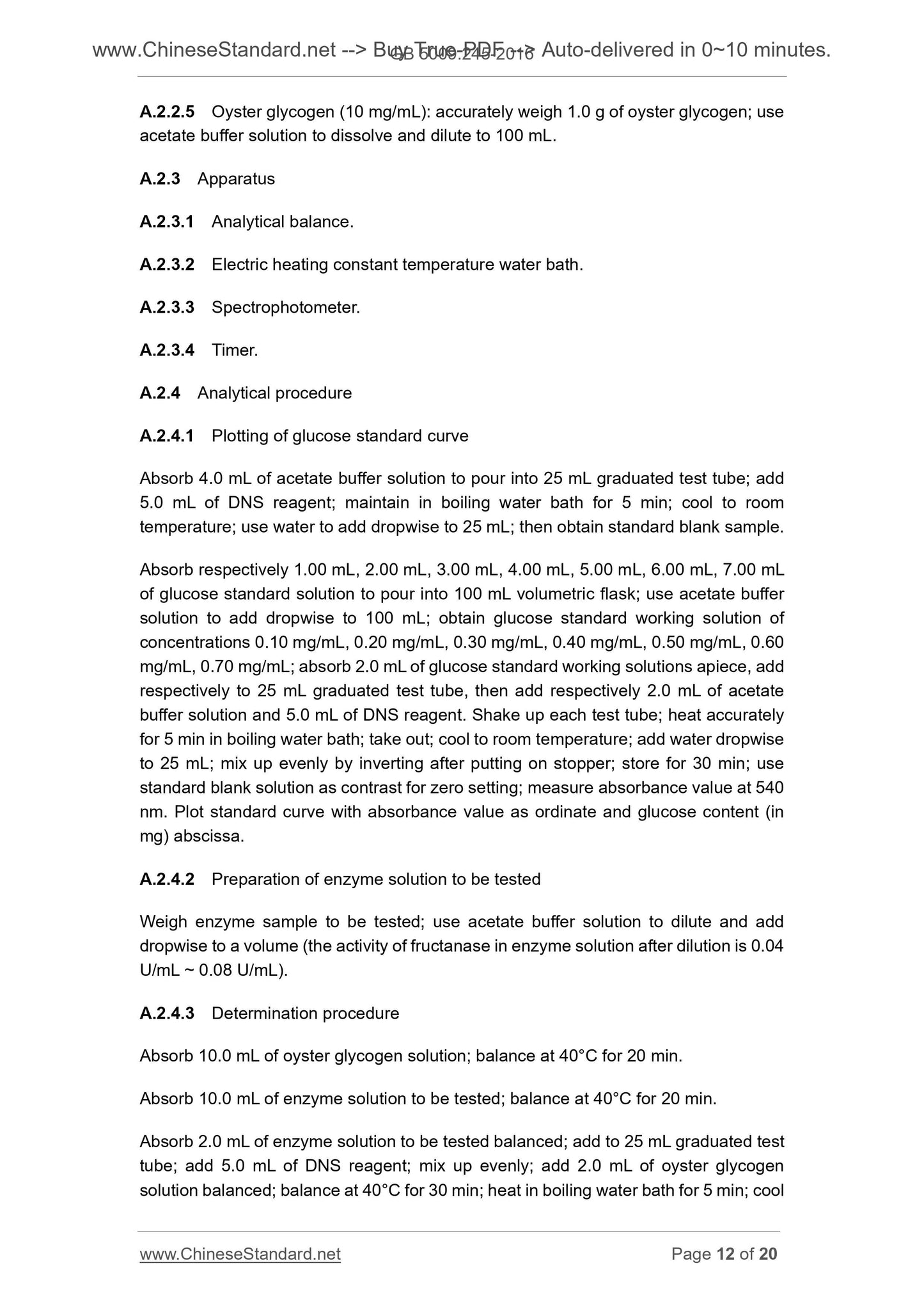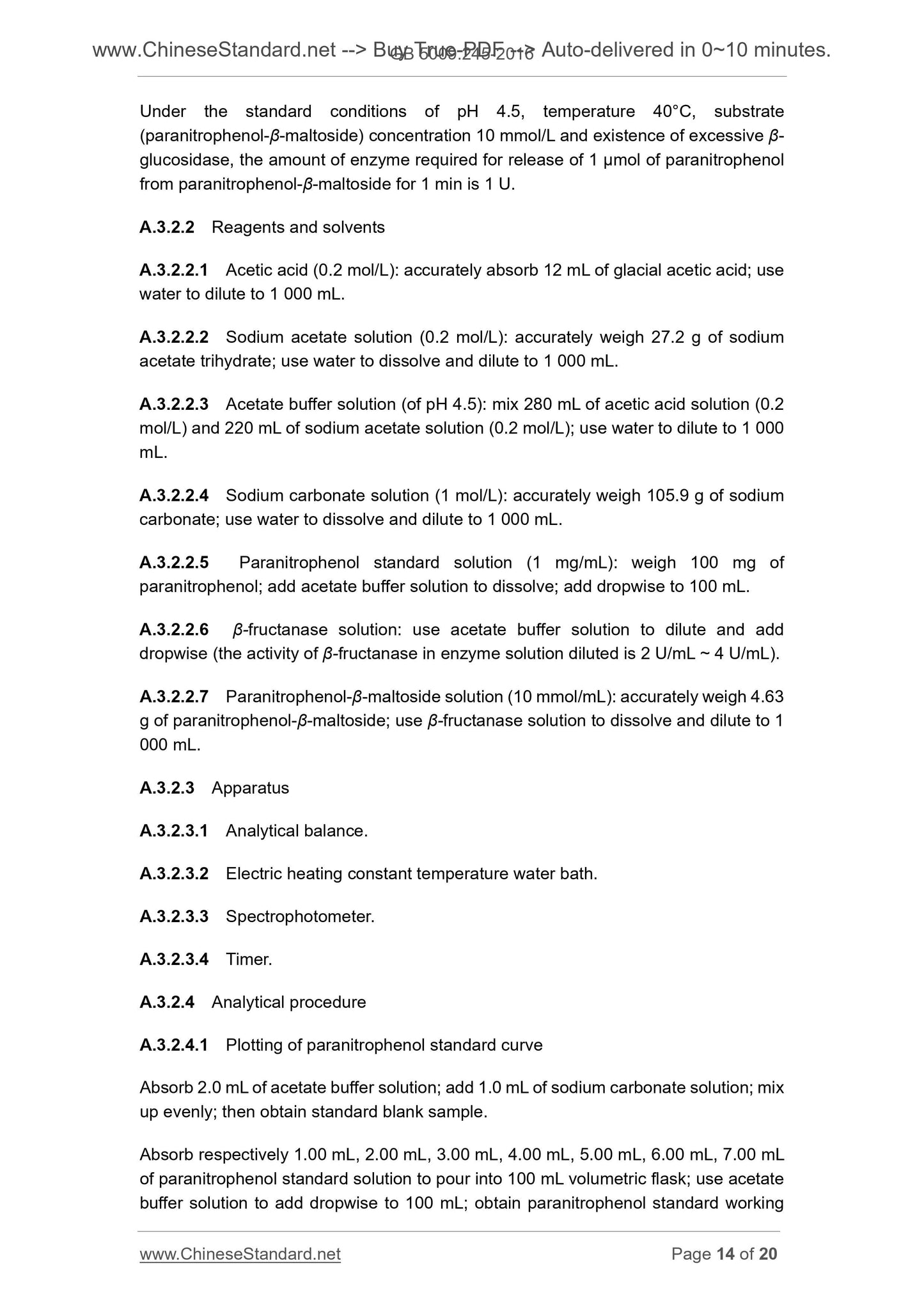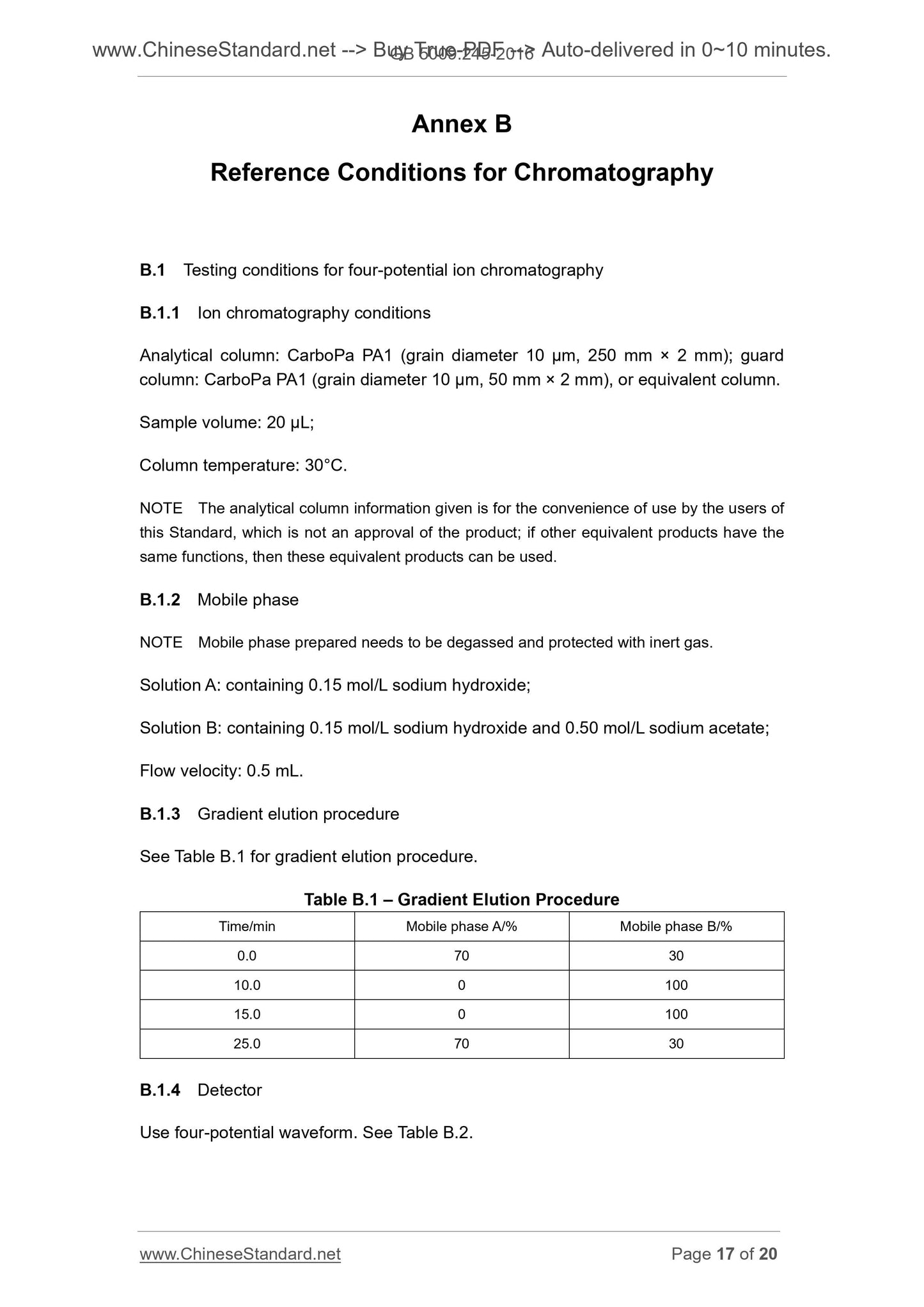1
/
of
8
PayPal, credit cards. Download editable-PDF & invoice in 1 second!
GB 5009.245-2016 English PDF (GB5009.245-2016)
GB 5009.245-2016 English PDF (GB5009.245-2016)
Regular price
$130.00 USD
Regular price
Sale price
$130.00 USD
Unit price
/
per
Shipping calculated at checkout.
Couldn't load pickup availability
Delivery: 3 seconds. Download true-PDF + Invoice.
Get QUOTATION in 1-minute: Click GB 5009.245-2016
Historical versions: GB 5009.245-2016
Preview True-PDF (Reload/Scroll if blank)
GB 5009.245-2016: Food safety national standard -- Determination of polydextrose in foods
GB 5009.245-2016
GB
NATIONAL STANDARD OF THE
PEOPLE’S REPUBLIC OF CHINA
National Food Safety Standard –
Determination of Polydextrose in Food
ISSUED ON. JULY 31, 2016
IMPLEMENTED ON. MARCH 1, 2017
Issued by. National Health and Family Planning Commission of the
People’s Republic of China
Table of Contents
1 Application Scope ... 3
2 Terms and Definitions ... 3
3 Principle ... 3
4 Reagents and Materials ... 3
5 Apparatus ... 5
6 Operating Procedure ... 6
7 Accuracy ... 7
8 Others ... 7
Annex A Enzyme Activity Determination ... 9
Annex B Reference Conditions for Chromatography ... 17
National Food Safety Standard –
Determination of Polydextrose in Food
1 Application Scope
This Standard specifies the method for determination of polydextrose in food.
This Standard applies to the determination of polydextrose added in food.
2 Terms and Definitions
For the purposes of this document, the following term and definition apply.
2.1 polydextrose [(C6H10O5)n]
A polymer which is made by mixing glucose, sorbitol and citric acid (or phosphoric acid)
in accordance with a certain proportion and heating polymerization, refining and dying
at high temperature, with an average polymerization degree 12. It is a soluble dietary
fiber.
3 Principle
Carry out hot water extraction and ultrafiltration centrifugation of polydextrose in food;
remove interfering substances in the filtrate such as starch and fructan; then use an
ion chromatography-pulsed amperometric detector for the quantitative determination
of polydextrose content.
4 Reagents and Materials
Unless specified otherwise, all reagents used for this method are guaranteed reagents
and the water is water grade II specified in GB/T 6682.
4.1 Reagents
4.1.1 Sodium hydroxide solution (50%). chromatographically pure, exclusive use for
ion chromatography.
4.1.2 Glacial acetic acid (CH3COOH).
4.1.3 Sodium acetate trihydrate (CH3COONa·3H2O).
4.1.4 Sodium acetate anhydrous (CH3COONa).
4.1.5 Fructanase. ≥ 2 000 U/mL.
4.1.6 Amyloglucosidase. ≥ 3 260 U/mL (soluble starch); ≥ 200 U/mL (p-NP-β
maltoside).
4.1.7 Isoamylase. ≥ 1 000 U/mL.
4.2 Preparation of reagents
4.2.1 Acetic acid solution (0.2 mol/L). accurately absorb 1.2 mL of glacial acetic acid;
use water to dilute to 100 mL.
4.2.2 Sodium acetate solution (0.2 mol/L). accurately weigh 2.72 g of sodium acetate
trihydrate; use water to dilute to 100 mL.
4.2.3 Acetate buffer solution (of pH 4.5). mix 28 mL of acetic acid solution (0.2 mol/L)
and 22 mL of sodium acetate solution (0.2 mol/L); use water to dilute to 100 mL.
4.2.4 Mixed enzyme solution. absorb and mix 680 μL of fructanase, 84 μL of
amyloglucosidase, 17 μL of isoamylase apiece; add acetate buffer solution to dilute to
20 mL. Prepare mixed enzyme solution immediately prior to use.
4.3 Mobile phase
4.3.1 Mobile phase A (containing 0.15 mol/L sodium hydroxide). accurately absorb
15.7 mL of sodium hydroxide solution (50%); use pre-degassed water to dilute to 2 L;
use an inert gas for protection.
4.3.2 Mobile B (containing 0.15 mol/L sodium hydroxide, 0.50 mol/L sodium acetate).
accurately weigh 41 g of sodium acetate anhydrous (or 68 g of sodium acetate
trihydrate); use mobile phase A to dissolve before adding dropwise to 1 L; mix up; pass
through 0.45 μm membrane; conduct degassing.
NOTE When preparing mobile phase, deionized water shall be pre-degassed for 0.5 h; mobile
phase shall be inverted for 5 ~ 6 times for mixing up before adding dropwise to a constant
volume; it shall not be shaken violently. Prepared mobile phase is poured in slowly along bottle
wall; it shall be protected with an inert gas after 0.5 h of degassing.
4.4 Reference substance
Polydextrose [(C6H10O5)n]. purity greater than 90%; CAS 68424-04-4.
NOTE In order to ensure the accuracy of results, reference substance from the same source
as polydextrose added in food shall be selected and achieve grade FCC, if the source of
polydextrose added can be determined.
4.5 Preparation of reference substance
4.5.1 Reference substance stock solution (2.00 mg/g). accurately weigh 0.20 g of
polydextrose reference substance (accurate to 0.000 1 g) to place into a pre-weighed
Annex A
Enzyme Activity Determination
A.1 Fructanase enzyme activity determination method
A.1.1 Principle
Under the standard conditions of pH 4.5, temperature 40°C and substrate (kestose)
concentration 10 mmol/L, the amount of enzyme required for release of 1 μmol of
fructose for 1 min is 1 U.
A.1.2 Reagents and solvents
A.1.2.1 Acetic acid (0.2 mol/L). accurately absorb 12 mL of glacial acetic acid; use
water to dilute to 1 000 mL.
A.1.2.2 Sodium acetate solution (0.2 mol/L). accurately weigh 27.2 g of sodium
acetate trihydrate; use water to dissolve and dilute to 1 000 mL.
A.1.2.3 Acetate buffer solution (of pH value 4.5). mix 280 mL of acetic acid solution
(0.2 mol/L) and 220 mL of sodium acetate solution (0.2 mol/L); use water to dilute to 1
000 mL.
A.1.2.4 Sodium hydroxide solution (2 mol/L). accurately weigh 80 g of sodium
hydroxide; use water to dissolve and dilute to 1 000 mL.
A.1.2.5 3,5-dinitrosalicylic acid reagent (DNS). add 6.3 g of 3,5-dinitrosalicylic acid
reagent and 262 mL of 2 mol/L NaOH solution to 500 mL of hydrothermal solution
containing 185 g of seignette salt; then add 5 g of phenol and 5 g of sodium sulfite; stir
to dissolve; add distilled water dropwise to 1 000 mL after cooling; store in brown bottle
as standby.
A.1.2.6 Fructose standard solution (1 mg/mL). accurately weigh 100 mg of analytical
pure fructose dried to a constant weight at 80°C and place into small beaker; transfer
to 100 mL volumetric flask; use acetate buffer solution to add dropwise to 100 mL; mix
up evenly; store in refrigerator at 4°C as standby.
A.1.2.7 Kestose solution (10 mmol/L). accurately weigh 5.04 g of kestose; use
acetate buffer solution to dissolve and dilute to 1 000 mL.
A.1.3 Apparatus
A.1.3.1 Analytical balance.
A.1.3.2 Electric heating constant temperature water bath.
A.2.2.5 Oyster glycogen (10 mg/mL). accurately weigh 1.0 g of oyster glycogen; use
acetate buffer solution to dissolve and dilute to 100 mL.
A.2.3 Apparatus
A.2.3.1 Analytical balance.
A.2.3.2 Electric heating constant temperature water bath.
A.2.3.3 Spectrophotometer.
A.2.3.4 Timer.
A.2.4 Analytical procedure
A.2.4.1 Plotting of glucose standard curve
Absorb 4.0 mL of acetate buffer solution to pour into 25 mL graduated test tube; add
5.0 mL of DNS reagent; maintain in boiling water bath for 5 min; cool to room
temperature; use water to add dropwise to 25 mL; then obtain standard blank sample.
Absorb respectively 1.00 mL, 2.00 mL, 3.00 mL, 4.00 mL, 5.00 mL, 6.00 mL, 7.00 mL
of glucose standard solution to pour into 100 mL volumetric flask; use acetate buffer
solution to add dropwise to 100 mL; obtain glucose standard working solution of
concentrations 0.10 mg/mL, 0.20 mg/mL, 0.30 mg/mL, 0.40 mg/mL, 0.50 mg/mL, 0.60
mg/mL, 0.70 mg/mL; absorb 2.0 mL of glucose standard working solutions apiece, add
respectively to 25 mL graduated test tube, then add respectively 2.0 mL of acetate
buffer solution and 5.0 mL of DNS reagent. Shake up each test tube; heat accurately
for 5 min in boiling water bath; take out; cool to room temperature; add water dropwise
to 25 mL; mix up evenly by inverting after putting on stopper; store for 30 min; use
standard blank solution as co...
Get QUOTATION in 1-minute: Click GB 5009.245-2016
Historical versions: GB 5009.245-2016
Preview True-PDF (Reload/Scroll if blank)
GB 5009.245-2016: Food safety national standard -- Determination of polydextrose in foods
GB 5009.245-2016
GB
NATIONAL STANDARD OF THE
PEOPLE’S REPUBLIC OF CHINA
National Food Safety Standard –
Determination of Polydextrose in Food
ISSUED ON. JULY 31, 2016
IMPLEMENTED ON. MARCH 1, 2017
Issued by. National Health and Family Planning Commission of the
People’s Republic of China
Table of Contents
1 Application Scope ... 3
2 Terms and Definitions ... 3
3 Principle ... 3
4 Reagents and Materials ... 3
5 Apparatus ... 5
6 Operating Procedure ... 6
7 Accuracy ... 7
8 Others ... 7
Annex A Enzyme Activity Determination ... 9
Annex B Reference Conditions for Chromatography ... 17
National Food Safety Standard –
Determination of Polydextrose in Food
1 Application Scope
This Standard specifies the method for determination of polydextrose in food.
This Standard applies to the determination of polydextrose added in food.
2 Terms and Definitions
For the purposes of this document, the following term and definition apply.
2.1 polydextrose [(C6H10O5)n]
A polymer which is made by mixing glucose, sorbitol and citric acid (or phosphoric acid)
in accordance with a certain proportion and heating polymerization, refining and dying
at high temperature, with an average polymerization degree 12. It is a soluble dietary
fiber.
3 Principle
Carry out hot water extraction and ultrafiltration centrifugation of polydextrose in food;
remove interfering substances in the filtrate such as starch and fructan; then use an
ion chromatography-pulsed amperometric detector for the quantitative determination
of polydextrose content.
4 Reagents and Materials
Unless specified otherwise, all reagents used for this method are guaranteed reagents
and the water is water grade II specified in GB/T 6682.
4.1 Reagents
4.1.1 Sodium hydroxide solution (50%). chromatographically pure, exclusive use for
ion chromatography.
4.1.2 Glacial acetic acid (CH3COOH).
4.1.3 Sodium acetate trihydrate (CH3COONa·3H2O).
4.1.4 Sodium acetate anhydrous (CH3COONa).
4.1.5 Fructanase. ≥ 2 000 U/mL.
4.1.6 Amyloglucosidase. ≥ 3 260 U/mL (soluble starch); ≥ 200 U/mL (p-NP-β
maltoside).
4.1.7 Isoamylase. ≥ 1 000 U/mL.
4.2 Preparation of reagents
4.2.1 Acetic acid solution (0.2 mol/L). accurately absorb 1.2 mL of glacial acetic acid;
use water to dilute to 100 mL.
4.2.2 Sodium acetate solution (0.2 mol/L). accurately weigh 2.72 g of sodium acetate
trihydrate; use water to dilute to 100 mL.
4.2.3 Acetate buffer solution (of pH 4.5). mix 28 mL of acetic acid solution (0.2 mol/L)
and 22 mL of sodium acetate solution (0.2 mol/L); use water to dilute to 100 mL.
4.2.4 Mixed enzyme solution. absorb and mix 680 μL of fructanase, 84 μL of
amyloglucosidase, 17 μL of isoamylase apiece; add acetate buffer solution to dilute to
20 mL. Prepare mixed enzyme solution immediately prior to use.
4.3 Mobile phase
4.3.1 Mobile phase A (containing 0.15 mol/L sodium hydroxide). accurately absorb
15.7 mL of sodium hydroxide solution (50%); use pre-degassed water to dilute to 2 L;
use an inert gas for protection.
4.3.2 Mobile B (containing 0.15 mol/L sodium hydroxide, 0.50 mol/L sodium acetate).
accurately weigh 41 g of sodium acetate anhydrous (or 68 g of sodium acetate
trihydrate); use mobile phase A to dissolve before adding dropwise to 1 L; mix up; pass
through 0.45 μm membrane; conduct degassing.
NOTE When preparing mobile phase, deionized water shall be pre-degassed for 0.5 h; mobile
phase shall be inverted for 5 ~ 6 times for mixing up before adding dropwise to a constant
volume; it shall not be shaken violently. Prepared mobile phase is poured in slowly along bottle
wall; it shall be protected with an inert gas after 0.5 h of degassing.
4.4 Reference substance
Polydextrose [(C6H10O5)n]. purity greater than 90%; CAS 68424-04-4.
NOTE In order to ensure the accuracy of results, reference substance from the same source
as polydextrose added in food shall be selected and achieve grade FCC, if the source of
polydextrose added can be determined.
4.5 Preparation of reference substance
4.5.1 Reference substance stock solution (2.00 mg/g). accurately weigh 0.20 g of
polydextrose reference substance (accurate to 0.000 1 g) to place into a pre-weighed
Annex A
Enzyme Activity Determination
A.1 Fructanase enzyme activity determination method
A.1.1 Principle
Under the standard conditions of pH 4.5, temperature 40°C and substrate (kestose)
concentration 10 mmol/L, the amount of enzyme required for release of 1 μmol of
fructose for 1 min is 1 U.
A.1.2 Reagents and solvents
A.1.2.1 Acetic acid (0.2 mol/L). accurately absorb 12 mL of glacial acetic acid; use
water to dilute to 1 000 mL.
A.1.2.2 Sodium acetate solution (0.2 mol/L). accurately weigh 27.2 g of sodium
acetate trihydrate; use water to dissolve and dilute to 1 000 mL.
A.1.2.3 Acetate buffer solution (of pH value 4.5). mix 280 mL of acetic acid solution
(0.2 mol/L) and 220 mL of sodium acetate solution (0.2 mol/L); use water to dilute to 1
000 mL.
A.1.2.4 Sodium hydroxide solution (2 mol/L). accurately weigh 80 g of sodium
hydroxide; use water to dissolve and dilute to 1 000 mL.
A.1.2.5 3,5-dinitrosalicylic acid reagent (DNS). add 6.3 g of 3,5-dinitrosalicylic acid
reagent and 262 mL of 2 mol/L NaOH solution to 500 mL of hydrothermal solution
containing 185 g of seignette salt; then add 5 g of phenol and 5 g of sodium sulfite; stir
to dissolve; add distilled water dropwise to 1 000 mL after cooling; store in brown bottle
as standby.
A.1.2.6 Fructose standard solution (1 mg/mL). accurately weigh 100 mg of analytical
pure fructose dried to a constant weight at 80°C and place into small beaker; transfer
to 100 mL volumetric flask; use acetate buffer solution to add dropwise to 100 mL; mix
up evenly; store in refrigerator at 4°C as standby.
A.1.2.7 Kestose solution (10 mmol/L). accurately weigh 5.04 g of kestose; use
acetate buffer solution to dissolve and dilute to 1 000 mL.
A.1.3 Apparatus
A.1.3.1 Analytical balance.
A.1.3.2 Electric heating constant temperature water bath.
A.2.2.5 Oyster glycogen (10 mg/mL). accurately weigh 1.0 g of oyster glycogen; use
acetate buffer solution to dissolve and dilute to 100 mL.
A.2.3 Apparatus
A.2.3.1 Analytical balance.
A.2.3.2 Electric heating constant temperature water bath.
A.2.3.3 Spectrophotometer.
A.2.3.4 Timer.
A.2.4 Analytical procedure
A.2.4.1 Plotting of glucose standard curve
Absorb 4.0 mL of acetate buffer solution to pour into 25 mL graduated test tube; add
5.0 mL of DNS reagent; maintain in boiling water bath for 5 min; cool to room
temperature; use water to add dropwise to 25 mL; then obtain standard blank sample.
Absorb respectively 1.00 mL, 2.00 mL, 3.00 mL, 4.00 mL, 5.00 mL, 6.00 mL, 7.00 mL
of glucose standard solution to pour into 100 mL volumetric flask; use acetate buffer
solution to add dropwise to 100 mL; obtain glucose standard working solution of
concentrations 0.10 mg/mL, 0.20 mg/mL, 0.30 mg/mL, 0.40 mg/mL, 0.50 mg/mL, 0.60
mg/mL, 0.70 mg/mL; absorb 2.0 mL of glucose standard working solutions apiece, add
respectively to 25 mL graduated test tube, then add respectively 2.0 mL of acetate
buffer solution and 5.0 mL of DNS reagent. Shake up each test tube; heat accurately
for 5 min in boiling water bath; take out; cool to room temperature; add water dropwise
to 25 mL; mix up evenly by inverting after putting on stopper; store for 30 min; use
standard blank solution as co...
Share
